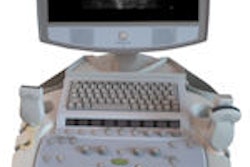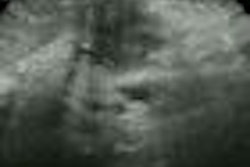Ultrasound is useful for the diagnosis, management, and follow-up of muscle tears and hematomas, according to research from Khoula Hospital in Muscat, Oman.
"Dynamic imaging is essential for diagnosing partial tears," said Dr. Ashok Kumar Nath. "We recommend use of diagnostic ultrasound in muscular trauma."
Nath presented the study findings during a scientific session at the recent American Roentgen Ray Society (ARRS) meeting in Boston.
Seeking to evaluate the role of dynamic ultrasound in muscular trauma, the Oman researchers studied its use in 50 male football (soccer) players. The players, who ranged in age from 20 to 30, presented with clinical muscular trauma in the thigh and calf region.
First, patients underwent a plain x-ray study to rule out bony injury. Dynamic ultrasound was then performed on both the affected and contralateral normal part with a PowerVision 6000 (Toshiba Medical Systems, Otawara, Japan) using a 7.5-11 MHz phased-array linear transducer in the sagittal, coronal, and angulated axis. Scanning was performed with and without muscle contraction, and all sonograms were recorded and reviewed by radiologists.
Needle aspiration of suspected hematomas was performed for diagnosis and treatment, according to Nath. In addition, all muscle tears and hematomas were studied and followed up after 72 hours until the patients were completely healed.
Of the 50 patients, 46 had muscle tears and/or hematomas in the thigh and calf region, while four had no abnormalities. Thirty-two patients had clear-cut complete muscle tears that appeared as echogenic retracted portions surrounded by hematomas ranging from highly reflective masses to complete echo-free areas on follow-up, he said.
The remaining 14 patients had partial tears, which appeared as hypoechoic subtle lesions with relaxed muscle and pseudotumors on contraction due to bunching together of partially broken muscle fibers, Nath said. This bunching appearance was diagnostic for partial tears, he said.
Healed tears appeared as highly reflective scar tissue. The ability to detect partial tears is important to allow the players to rest to avoid full tears or hematomas, he said.
"Ultrasound is a cheap and readily available radiation-free diagnostic imaging modality useful for diagnosis and follow-up of muscle tears and for localizing hematomas for draining and follow-up," he said.
By Erik L. Ridley
AuntMinnie.com staff writer
July 13, 2009
Related Reading
Radiology faces declining share of musculoskeletal ultrasound, January 20, 2009
Ultrasound can boost imaging use in developing countries, November 21, 2008
Pictorial essay: 3D ultrasound reveals shoulder pathology, March 21, 2008
Ultrasound performs well in meniscal tears, February 5, 2008
Comprehensive musculoskeletal US exam offers most value, January 3, 2008
Copyright © 2009 AuntMinnie.com



















